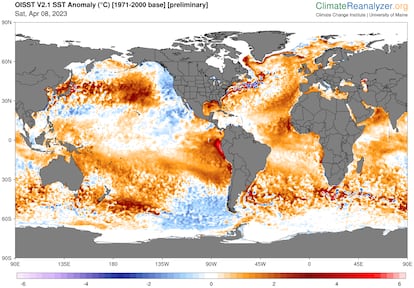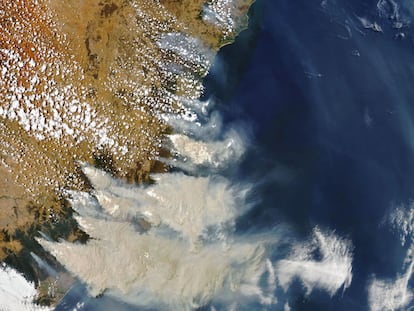Average sea surface temperature sets new high in 40 years of record-keeping
Meteorology experts warn that we are ‘entering an unknown climate frontier’ as human action continues to alter the cyclical warming and cooling of the oceans


The National Oceanic and Atmospheric Administration of the United States (NOAA) reported that the average temperature of the world’s sea surface reached 21.1 °C (70ºF) in April, a new high since official records began over four decades ago. “We are entering unknown climate and meteorological territory and crossing borders that have never been crossed before,” said Francisco Martín León, a meteorologist and science communicator.
The last time similar temperatures were reached, seven years ago, they were driven by the El Niño phenomenon, which cyclically warms the tropical areas of the Pacific Ocean. But right now the world is in a neutral climate period, and the cause points to global warming by greenhouse gas emissions.
Since 1981, NOAA has been observing the behavior of Earth’s open waters, using satellites, buoys and ships to measure and estimate the sea surface temperature (SST). Although this is a relatively brief period of time in terms of climate, it is the most reliable existing data on the subject. The agency’s preliminary measurements show that on April 5, the surface temperature of the seas located between 60 degrees north and 60 degrees south exceeded 21ºC, that is, everywhere save in the poles.
The oceans are subject to two natural, changing and opposing cyclical climatic phenomena: El Niño, which warms the waters of the tropical Pacific, and La Niña, which cools them. Three years of La Niña in that ocean have helped reduce temperatures and cushion the effect of increased greenhouse gas emissions. “In 2016 there was a warm phase with positive anomalies, called the Super Niño, which contributed so much to the rise in temperatures that it led to the latest record. However, at the moment La Niña has just ended, which means that even though we are in a neutral phase in the tropical Pacific, all modern records are still being exceeded,” says Martín León.
According to this physicist, who worked at Spain’s national weather agency Aemet for more than three decades, “global warming of anthropogenic origin is being stored in marine waters. Between 80% and 90% of the excess energy ends up in the oceans. That is why the seas are also suffering from heat waves, and as a result we are having abnormally high temperatures at this time of the year, in the North Atlantic and in the Mediterranean.” Sea surface temperatures in the North Atlantic have exceeded 22ºC (71.6ºF), something unusual in the spring, while the Center for Environmental Studies of the Mediterranean (CEAM) has also warned of exceptionally warm measurements in that body of water.

“The oceans are entering uncharted territory,” said Juan Jesús González Alemán, a senior meteorologist at Aemet, in his Twitter account. “As part of their upward warming trend of the last decades, this past week they exceeded the barrier of 21ºC of surface temperature globally. Something like this had not been seen since record-keeping began […] Something very striking is happening in the North Atlantic, where we have already had a month of record warming,” he added.
Martín León considers that “human beings are doping up the atmosphere and oceans with their emissions of greenhouse gases, and this has consequences for the meteorological system.” For this reason, when the next Niño arrives, foreseeably next summer, even higher temperatures are expected in the seas. “The problem is that greenhouse gases already have more intense effects than El Niño or La Niña. Before, when there was a La Niña phase, a certain cooling of the Earth’s temperature was noticeable, but lately it is becoming less and less noticeable.”
The warming of the seas causes them to generate more water vapor and this has effects on the weather: in these conditions, if there is a storm, it is very likely that it will produce very intense rain or snow. The warmer the water, the more likely it is to generate extreme weather events. In addition, these conditions increase the thermal stress of marine animals, which can affect the food chain and, ultimately, human nutrition.
Sign up for our weekly newsletter to get more English-language news coverage from EL PAÍS USA Edition
Tu suscripción se está usando en otro dispositivo
¿Quieres añadir otro usuario a tu suscripción?
Si continúas leyendo en este dispositivo, no se podrá leer en el otro.
FlechaTu suscripción se está usando en otro dispositivo y solo puedes acceder a EL PAÍS desde un dispositivo a la vez.
Si quieres compartir tu cuenta, cambia tu suscripción a la modalidad Premium, así podrás añadir otro usuario. Cada uno accederá con su propia cuenta de email, lo que os permitirá personalizar vuestra experiencia en EL PAÍS.
¿Tienes una suscripción de empresa? Accede aquí para contratar más cuentas.
En el caso de no saber quién está usando tu cuenta, te recomendamos cambiar tu contraseña aquí.
Si decides continuar compartiendo tu cuenta, este mensaje se mostrará en tu dispositivo y en el de la otra persona que está usando tu cuenta de forma indefinida, afectando a tu experiencia de lectura. Puedes consultar aquí los términos y condiciones de la suscripción digital.
More information
Archived In
Últimas noticias
NASA discovers Titan doesn’t have an ocean, but a ‘slushy ice layer’ that increases possibility of life
Innocence lost in the forest of the child soldiers: ‘Each leader of the armed group had his girls’
‘Fallout’ or how the world’s largest company turned an anti-capitalist apocalyptic Western into a phenomenon
From inflation to defending migrants: Eileen Higgins and Zohran Mamdani inaugurate the new Democratic resistance against Trump
Most viewed
- ‘El Limones’ and the growing union disguise of Mexican organized crime
- Christian Louboutin: ‘Young people don’t want to be like their parents. And if their parents wear sneakers, they’re going to look for something else’
- The low-cost creative revolution: How technology is making art accessible to everyone
- ‘We are dying’: Cuba sinks into a health crisis amid medicine shortages and misdiagnosis
- Liset Menéndez de la Prida, neuroscientist: ‘It’s not normal to constantly seek pleasure; it’s important to be bored, to be calm’









































